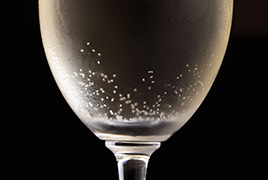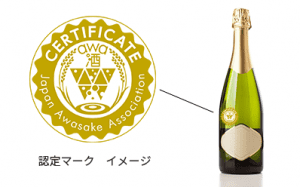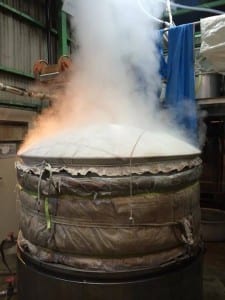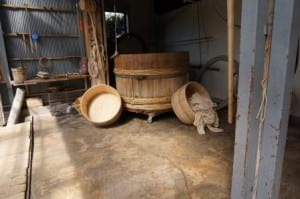Announcing the establishment of the “awa Sake Kyokai”
 On November 1 of last year, eight sake brewing companies formed the “ awa Sake Kyokai,” or the “Sparkling Sake Association.” On April 14, 2017, the awa Sake Kyokai had increased its membership to nine, and held its inaugural event in Tokyo.
On November 1 of last year, eight sake brewing companies formed the “ awa Sake Kyokai,” or the “Sparkling Sake Association.” On April 14, 2017, the awa Sake Kyokai had increased its membership to nine, and held its inaugural event in Tokyo.
With respect to the name: the word awa means foam, or bubbles. The official Japanese same keeps the word awa in English, with sake and kyoukai in Japanese. Furthermore the word awa is not capitalized. (Explaining this seemed better than just writing (sic) after the word awa. But I digress.)
The purpose of the group is to produce and promote high quality sparkling nihonshu. With the Olympics coming to Tokyo in a scant three years, the member brewers decided it would be good to have a type of sake that can be enjoyed in a toast much like a sparkling wine or Champagne.
Let us briefly look at the sparkling sake market as a whole, and then at the awa Sake Kyokai in more detail.
I have not found accurate numbers of how many sparkling sake products there are in awa sake kyokai certification mark
Japan right now, so the below is my own estimate. In truth, I doubt there are any hard stats, since sparkling sake is classified as sake, i.e. as far as the government is concerned, it is the same stuff. Still, I do have confidence in the numbers here, even if they are my own approximation.
There are 1200 breweries in Japan (1241 this year, to be exact.) Let’s say they average 20 to 25 products each, including seasonal variations. That is about 25,000 sake products in Japan. I think there are significantly less than 200 sparkling sake products on the market. So that means that sparkling sake, in terms of number of products, is less than one percent of the market. In terms of volume produced, it is way, way less than one percent.
The point is not to trivialize it; on the contrary, I do want to support the development of this sector of the sake world. However, it is important to point out that sparkling sake is not to the sake world what sparkling wine and champagne are to the wine world. Not even close.
Also, note that there are a handful of ways to make sparkling sake. It is legal to just pump regular sake with carbon dioxide, and fast and easy as well. As such, a good number of sparkling sake products are made in this way. It is also common to leave some sugar in the sake after pressing, and add a bit of the yeast-laden foam back into the bottle to do a secondary fermentation in the bottle, trapping the gas inside. There are variations and other methods as well.
Back to the awa Sake Kyokai, even though there are plenty of producers making sparkling sake, there are only nine members. While there are likely several reasons for this (some of which are beyond the scope of this newsletter), certainly one is the strict set of conditions to which sake made under this banner must comply.
Those conditions are:
 1. Made with rice, rice koji, and water, and conforming to the legal definition of nihonshu.
1. Made with rice, rice koji, and water, and conforming to the legal definition of nihonshu.
2. Made with rice that has passed legal quality inspection.
3. Contains only naturally occurring carbon dioxide resulting from fermentation.
4. Transparent in appearance, with visible bubbles when poured.
5. Minimum ten percent alcohol.
6. Minimum pressure of 3.5 bar at 20C
Also, a further stipulation is that the flavors and aromas must remain stable for at leaest three months in the bottle.
So many products on the market do not meet one or more of the specifications above an so will not be marketed under the awa Sake Kyoukai organization’s efforts. It might be alcohol that is not high enough, cheap rice, methods that do not comply, or added fruit flavors (legally rendering them something other than sake) or more. In fact, there are many well known, well marketed and very visible sparkling sake that are not a part of this organization. Which is fine.
The nine breweries are: Tenzan, Hakkaisan, Chiyomusubi, Shichiken, Nanbu Bijin, Mizubasho, Kikuizumi, Fukumitsuya and Dewatsuru. The current chairman is Noriyoshi Nagai, president of Mizubasho. Some of these breweries have more than one conforming product available, while two do not yet even have a conforming product on the market. More members as well as more products from those members can be expected.
While there are various opinions on sparkling sake overall, it is a real and fast growing sector of the sake market and should be encouraged. Note, too, that relatively little sparkling sake is being exported. A bit is, to be sure, and that bit is growing. Certainly the efforts of the awa Sake Kyokai will help that.
While it may or may not rival champagne in the future, the sparking sake sector is bubbling up, and likely to come to a head at some point in time. At least, it is certainly moving in a positive direction.







